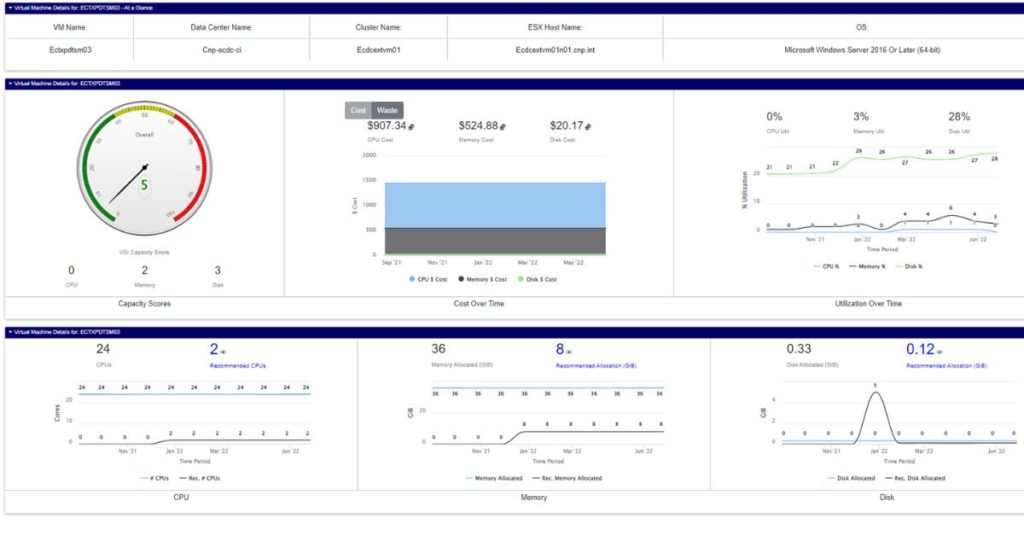Share this:
It’s another inflation record: year-over-year US consumer prices rose by 9.1% in June of 2022, the highest in over 40 years.
And after months of increasing costs – and despite government measures to fight inflation – US consumer expectations for the future are worse than ever.
The last time the US saw serious and sustained inflation, the IT industry was just flickering on.
Back then, Seagate was creating the first microcomputer HDD with a whopping 5 MB of data capacity and IBM was releasing one of the very first PCs to gain widespread acceptance.
Today, IT and enterprise storage are unrecognizable – with virtualization and device capacities that are exponentially larger (and then some).
The truth is that no one has ever worked in modern IT environments and experienced inflation. This is uncharted waters for everyone.
That doesn’t mean things need to feel mysterious, however.
Just like any challenge, inflation causes certain predictable effects for IT departments and enterprise infrastructure teams. IT leaders can anticipate those effects, evaluate their potential impact in their environment, and prioritize strategic decisions to address them.
Within enterprise storage infrastructures, inflation (and the looming threat of a potential recession) has recognizable impacts on capital expenditures and operational expenses.
Let’s look at ways forward for IT storage leaders in both areas.
Capping CapEx: Tips for Maximizing Storage Assets
Capital expenditures – or CapEx – might be some of the first items on the cutting board during prolonged inflation.
The most expensive budget items look less attractive when other costs are rising – especially if it’s an item like storage hardware that you might not purchase often.
In fact, inflation has put storage hardware in a unique market position. As one IDC article notes, rising hardware costs “stand in stark contrast to the usual tendency for hardware prices, which for decades have been marked by falling prices for equivalent computing power.”
In other words, this might be the first time ever that you would pay more for the same amount of storage (all other conditions being equal).
Not an ideal time to break the bank for storage!
And if you think you can just wait things out, you might be in for a costly surprise.
With no end to supply chain delays in sight, there is an industry consensus that higher CapEx prices will continue into 2023 and 2024.
Despite so much uncertainty, you don’t have to just “suck it up” and spend more (if your boss would even let you).
Instead, maximize your existing assets first.
That way, you can reduce or delay big-ticket purchases. And when you truly need to spend on new devices, you’ll have good-faith evidence for administration that you’re actively minimizing purchases and optimizing all assets.
There are lots of ways to get more out of your devices; here’s a couple of questions to ask yourself:
How much of your past CapEx spending is sitting unused on your hardware?
Yes, hardware-centric storage environments should maintain storage reserves in case of emergency. But many admins and architects are surprised to learn how much available space is hiding on their devices under the guise of being “in use” despite not being touched.
For example, lots of storage gets allocated to projects that later are abandoned or replaced. These LUNs look active but are unmapped – ready for action, but hidden from sight.
Similarly, small quantities of unused storage tend to fragment across pools and volumes – neither reserved for the future nor big enough to use now. And some devices don’t always report this free space. (NetApp pools with free space fragmented across volumes are listed as full even if some re-provisioning within the pool would free entire volumes.)
Let’s say you need to allocate 200 TB for a project. Instead of paying record-high rates for a new device, better visibility could empower you to use an older device (purchased at much lower rates) instead.
In fact, one of our clients avoided $1 million in spending by discovering over 700 TB of unused storage just by using Visual One Intelligence over the course of a month.
How much of your CapEx spending is wasted on third-tier data?
In the same way, plenty of teams let old, unused, or archivable data collect dust in tier-one storage simply because it’s easier. But that’s a mistake when tier-one devices are at an all-time premium.
With a low-cost file analysis tool, they could quickly identify groups of files eligible for re-tiering or archiving on cheap storage in accordance with company regulations.
How confidently can you forecast future capacity requirements?
Of course, some expenses are inevitable.
At some point, you will have to purchase additional storage. The key is to see it coming – and not buy more than you need just because you can’t forecast future consumption with confidence.
That’s a difficult needle to thread. With ongoing supply chain delays, many decision-makers have no choice but to order hardware months in advance. And everyone would agree it’s important to have a cushion in case your projections are off.
Capacity planning can be complex, especially in multi-vendor environments.
That’s why there are tools designed to collect all your data on a single pane of glass and automate utilization trends.
For example, Visual One Intelligence offers three different kinds of responsive models to evaluate past behavior and forecast future expectations – even when you expect workloads to change contrary to previous trends.
And remember to set capacity thresholds low enough that you’ll be alerted long before a device fills up – nothing will torpedo your spending plans like emergency hardware purchases.
Reining In OpEx: Chart a Path for Efficiency
Operational expenses – or OpEx – inevitably rise during inflation.
As a matter of fact, it might feel like they inevitably rise no matter what is going on in the economy. Operating costs have a habit of spiraling quickly. A few new subscriptions here, a couple of managed services there, and pretty soon your budget is ballooning.
(That’s without mentioning salaries, a significant OpEx source that is escalating in IT thanks to inflationary pressures and the “Great Resignation.”)
In addition, you might be one of many IT departments that are switching from CapEx storage models to OpEx storage models.
Usually, this entails adopting consumption-based storage habits by migrating to the cloud. A July 2022 research report expects the cloud storage market to more than double by 2027, and Gartner predicts 51% of applicable IT spending to shift to the public cloud by 2025.
And big-name storage vendors are starting to offer their own consumption-based storage models, such as HPE’s Greenlake and Pure Storage’s Pure as a Service.
All together, IDC data from June 2022 indicated a 5-7% increase in enterprise software and IaaS cloud prices over the last two years – with further increases likely as inflation persists.
This obviously converts traditionally CapEx costs into widening operational expenses in a way that is acutely painful during inflationary periods.
But just as with storage CapEx, you’re not at the mercy of your vendors. Ask yourself the following questions:
Could I be paying less for storage contracts?
If your OpEx is already going towards consumption-based storage, don’t just set it and forget it. Take a closer look – you might be spending more than you need.
First, make sure you’re truly paying market value. If your provider raised rates due to inflation, due a little comparison pricing. You’re probably not going to change providers (any cost savings would be offset by migration costs), but it can give you a good baseline in contract negotiations and let you know if the price increase is excessive.
Then, examine your storage trends from the past year. How much paid-for storage capacity went unused, and what was the cost?
Run capacity planning projections based on those trends plus future expectations – can you confidently forecast needing less capacity on your next contract? Even if not, capacity planning provides a critical benchmark for selecting the size of your contract.
Whether using a pay-as-you-go or pay-per-use contract structure, strong capacity planning guides you towards the sweet spot between paying for too much storage or not enough.
If I haven’t already, should I migrate to the cloud?
If you’re just now considering data migration (or, you want to migrate more of your hybrid storage to the cloud), inflation-driven price increases might be giving you second thoughts.
Still, don’t miss the big picture. Storage subscription costs may be higher than before, but that doesn’t mean they’re not an improvement over your current infrastructure model.
The only way to know is to ask the question and do the analysis.
Some of our own clients have been doing this, using Visual One Intelligence to evaluate past performance trends, determine which devices make sense for migration, and identify how much money would be saved by migrating (based on market values).
Is there organizational storage waste that can be reduced?
OpEx incurred by other users throughout the organization might be out of your control, but you can help those users align their usage with their actual needs.
The fact is that many users take IT resources for granted, and that’s okay. Jim from Sales isn’t thinking about how much it costs to allocate his storage space or purchase his software licenses (half of which he doesn’t use).
With a smooth showback program, you can show department managers what they wouldn’t otherwise see. Sometimes, that’s all it takes to cut back on things like unneeded licenses and excess storage allocations.

How Much Could You Save?
From workload optimization to automated capacity planning, see how much CapEx and OpEx Visual One Intelligence could help you save.
Spending Smarter is More Important Than Spending Less
Whether the economy is whirring, heating up too fast, or sliding into recession, the basic metric by which IT spending will be evaluated is always the same: profitability.
It’s not always about cutting costs.
Reducing spending might help improve profitability, but it might also have the opposite effect by eliminating critical resources.
Sometimes, you have to spend money to save money.
At the beginning of 2022, IDC research suggested most IT organizations planned to keep or grow technology investments in the coming year. Despite inflation, Gartner research in May of 2022 indicated that 78% of CFOs still planned the same kind of investments over the next two years even if inflation forces them to cut costs in other areas.
This is especially important if the economy swings the other direction into a recession. If there’s no choice but to tighten the belts, it pays (literally) to have innovations in place that are actively saving money without reducing productivity.
Are you continuing with “business as usual”? Or are you discovering opportunities to build resiliency and efficiency into your organization’s storage infrastructure?
Visual One Intelligence can help – we give teams better visibility across multi-vendor enterprise storage environments and automate the kinds of efficiencies that save significant time and money both now and in the future.
Let us show you how we do it.
With new economic winds reshaping the IT infrastructure landscape, this is a perfect time to explore new opportunities.








